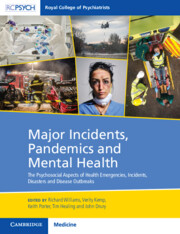 Major Incidents, Pandemics and Mental Health
Major Incidents, Pandemics and Mental Health from Section 5 - Sustaining and Caring for Staff During Emergencies
Published online by Cambridge University Press: 11 January 2024
This chapter outlines what occupational health services are and what they can do for workers and employers. It describes their role in preventing and managing illness caused by work, and supporting workers to return to their workplaces after illness. Of key importance is the management of hazard and risk at work, and preventing harm to workers. This includes anticipating the psychosocial hazards of emergencies, incidents, disasters, and disease outbreaks (EIDD), and planning how to keep staff safe and well. In the context of the COVID-19 pandemic, the additional prolonged health impacts of COVID-19 affecting a large proportion of the population have been and are challenging for all concerned. The author uses Long COVID to consider how health services might be organised and delivered at scale. Occupational health services are accustomed to turning their capabilities to meet new needs. Early intervention is emphasised as a means of achieving earlier return to function.
To save this book to your Kindle, first ensure [email protected] is added to your Approved Personal Document E-mail List under your Personal Document Settings on the Manage Your Content and Devices page of your Amazon account. Then enter the ‘name’ part of your Kindle email address below. Find out more about saving to your Kindle.
Note you can select to save to either the @free.kindle.com or @kindle.com variations. ‘@free.kindle.com’ emails are free but can only be saved to your device when it is connected to wi-fi. ‘@kindle.com’ emails can be delivered even when you are not connected to wi-fi, but note that service fees apply.
Find out more about the Kindle Personal Document Service.
To save content items to your account, please confirm that you agree to abide by our usage policies. If this is the first time you use this feature, you will be asked to authorise Cambridge Core to connect with your account. Find out more about saving content to Dropbox.
To save content items to your account, please confirm that you agree to abide by our usage policies. If this is the first time you use this feature, you will be asked to authorise Cambridge Core to connect with your account. Find out more about saving content to Google Drive.